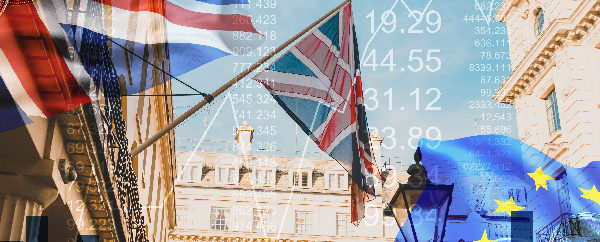A decade on from the global recession sparked by the sub-prime lending crisis and resulting credit crunch in the US, could Uncle Sam trigger another downturn that lasts for much of the 2020s?
The US has been unpredictable during President Donald Trump’s administration, leading to a trade war with China and significant tariffs on imports from that country and others.
But that’s not all. In October 2019 the World Trade Organization sided with the US in a dispute with the EU, effectively authorising the US to impose tariffs on EU goods of up to 100%.
These tariffs potentially include 25% on agriculture and 10% on aircrafts – contributing $1.3 billion to the US’s total tariff intake, according to the Tax Foundation, in addition to the massive $79.3 billion of tariffs imposed on China.
Generally speaking, tariffs are not good for the global economy. Successive quarters of high tariffs could quickly see the world economy enter recession.
This is nothing new – tariffs are widely regarded as being responsible for how deep and protracted the Great Depression was in the 1930s and may even have contributed towards triggering the outbreak of World War II.
Why is the US imposing tariffs?
President Trump has been imposing tariffs throughout his administration as a way to boost the domestic manufacturing sector in the US, including particular steps to increase the cost of importing aircraft from Europe.
Earlier in the year, this led to the Boeing-Airbus state subsidy dispute entering a new phase. As of October, the door is open for tariffs on aircraft sold by EU manufacturers to the US.
Combined with the impact of the China trade war, this has essentially imposed tax increases on US citizens, equivalent to around 40% of the money that had previously been saved via the 2017 Tax Cuts and Jobs Act.
According to the Tax Foundation, the actions taken by the Trump administration on tariffs have cost Americans $87 billion, damaged the economic wellbeing of the US, reduced real-terms income, cost jobs and reduced productivity.
The US is the globe’s benchmark economy – the vast majority of commodities and investments are valued using the US dollar – and if the negative impacts of tariffs start to emerge in the form of a US recession, this could create significant cause for concern worldwide.
Is the US heading for recession?
It is difficult to predict a recession with any certainty, but the IMF recently called for urgent action to improve economic stability especially in response to spiralling corporate debt in the US.
Whereas policy decisions in China and the Eurozone have already begun to implement measures to protect the corporate sector, momentum in the US is still heading in the opposite direction.
One example of this was the US Federal Reserve’s decision to cut interest rates by 25 basis points to a target range of between 1.75% and 2.00% in September 2019.
The move was immediately criticised by President Trump via Twitter, where he wrote: “Jay Powell and the Federal Reserve Fail Again. No “guts,” no sense, no vision!”
In practical terms, even lower interest rates could contribute further to the rapidly rising corporate debt level in the US and while this alone is not necessarily a cause for concern, coupled with the country’s ongoing trade wars it could ultimately trigger a recession.
Were it to occur, this would give President Trump the dubious legacy of having brought to an end the longest economic expansion in US history, dating back to June 2009.
Quantitative Transparency
Investors are watching the Fed carefully. By early 2018 the US central bank had implemented three phases of Quantitative Easing – effectively printing money in order to inject extra funds into the economy.
But in 2018 this cycle shifted instead to Quantitative Tightening. As US investor Jim Rickards told the Telegraph: “Instead of throwing money out of a helicopter, they started chucking it into a furnace.”
However, investors have recognised a decrease in transparency in the Fed’s QE efforts, notably the bank’s $1 trillion foray into the repo market, in which companies and banks can trade bonds for cash and then redeem them, often as soon as overnight.
This has been branded QE4 by some investors as its real-terms impact on the economy is that of Quantitative Easing, but with much less transparency.
At times in recent weeks the ‘repo rate’ has spiked, a suggestion that the banks are less willing to lend to each other and a harbinger of a possible credit crisis or even a major financial institution collapse like those seen in 2007-08.
Shocking effects
For now none of these indicators are absolute – individually they do not represent a severe risk, but together the picture they paint is an unsteady and uncertain one especially for the US, but also for economies worldwide that depend on US economic stability.
Political upheavals are on the horizon as President Trump faces impeachment proceedings and the UK and Eurozone continue to work towards achieving some form of Brexit.
If something shocking were to occur in the global economy and/or the tariffs and trade wars were to worsen again in the coming months, it could be enough to push the zombie economy of the US over the edge into negative territory.
How deep it might plunge and how far down it would drag the other major and emerging economies of the world is impossible to predict – and something investors are right to keep a watchful eye on.
https://taxfoundation.org/tariffs-trump-trade-war/
https://www.telegraph.co.uk/business/2019/10/05/us-stall-could-mean-head-fall/
https://drive.google.com/file/d/1-Z2Y_8gARHGaAzBZp96h88DvxHQtDk7_/view?usp=sharing
Disclaimer: The information provided here is not investment, tax or financial advice. You should consult with a licensed professional for advice concerning your specific situation.




